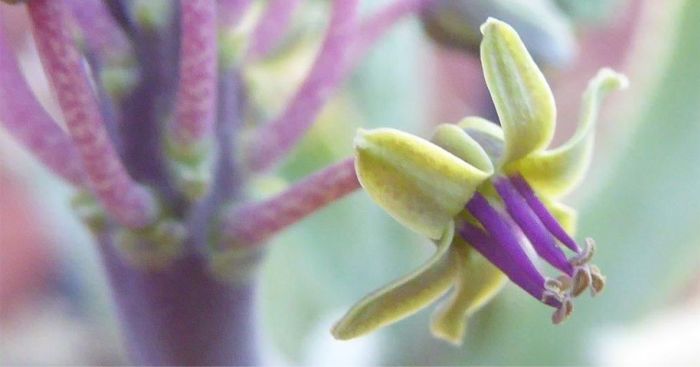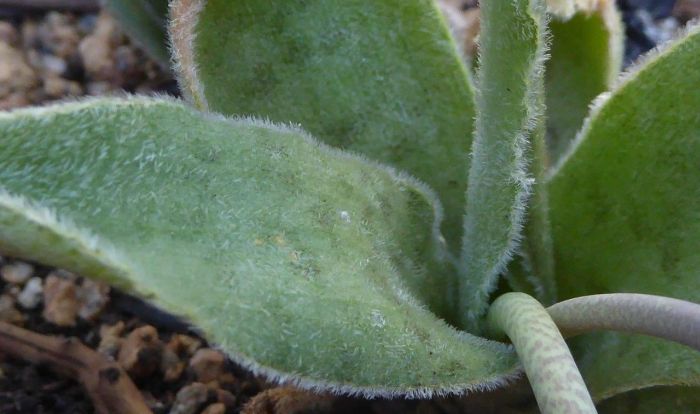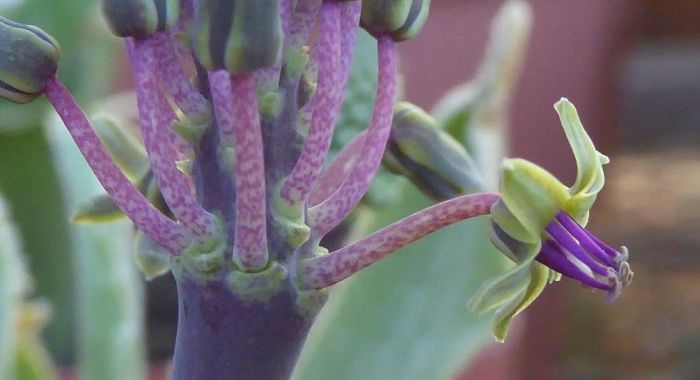Ledebouria hypoxidioides
Ledebouria hypoxidioides (Schönland) Jessop
Family: Hyacinthaceae
Common names: Grahamstown African hyacinth
Introduction
A highly unique species in the genus since it is the only species with leaves that are densely covered with shaggy hairs. This species is also only known to occur in the vicinity of Grahamstown in the Eastern Cape Province of South Africa.

Description
Description
Bulbous plants 100–150mm high, with pale to mid-green, densely hairy, unspotted, deciduous leaves; occurring as solitary individuals or in small groups of a few bulbs. 1 to 3 inflorescences are produced in spring and early summer (October to December) oriented outwards from between the leaves, bearing numerous, small, inconspicuous, green to purplish green flowers. The individual florets (small flowers) are comprised of 6 recurved tepals (petals). Flowers are followed quickly by green, swollen, 3-chambered fruits, which split to reveal small, glossy, black seeds.

This species cannot be confused with any other species of Ledebouria, since the densely hairy leaves are diagnostic.

Conservation Status
Status
This species is listed as Least Concern (LC), which means it is not considered to be threatened in its natural habitat. Although this may need to be re-assessed, as the expansion of the city of Grahamstown results in loss of habitat for the species.
Distribution and habitat
Distribution description
This species occurs only in and around the city of Grahamstown in the Eastern Cape Province of South Africa.
Derivation of name and historical aspects
History
As with many members of this genus, this species was initially placed in the genus Scilla when it was first named by Schönland. It was later moved to the genus Ledebouria by J.P. Jessop during his revision of the genus in 1970. The genus is named in honour of the German-Estonian botanist, Professor Carl Friedrich von Ledebour (1785–1851). The specific name hypoxidioides is named in reference to the resemblance to plants of the genus Hypoxis. South Africa has 58 species of Ledebouria, with several more species occurring across southern, western, eastern and northeast Africa and into India.

Ecology
Ecology
There is no documented information on the ecology of Ledebouria hypoxidioides. Porcupines are known to dig out and eat the bulbs of several species of Ledebouria and large ungulates have been observed to browse the leaves. The densely hairy leaves may offer some protection from predation by insects. Hairy leaves may also offer protection from desiccating heat, by providing some shading of the leaf surface, as well as reducing the amount of moisture loss though contact with hot, dry winds.
The flowers are open and cup-shaped with their pollen openly presented, which suggests that the flowers are opportunistically pollinated by most visiting insects. In the wild many different insects can be seen visiting the flowers, which have not been recorded as being scented. The inflorescences are mostly erect to spreading at first, becoming more flaccid (floppy) with age; this may have something to do with optimizing visibility of the flowers to attract pollinators. The seed is small, black and roundish with a wrinkled surface. Venter (1993) suggests that Ledebouria seeds may be distributed by water wash, which is likely after heavy thunderstorms, which are frequent across the areas where the species occurs.
Uses
Use
The genus Ledebouria is cited as having been used medicinally for various purposes, including pregnancy, diarrhoea, influenza, backache, skin irritations, wound treatment, as well as lumbago. The genus is also reported as being poisonous, although it is also reported that bushmen ate the bulbs of certain species, including L. revoluta and L. apertiflora. However, these may have been cooked or prepared in some manner to destroy the toxins, which is not specifically documented. Despite the fact that some large ungulates do browse the leaves, the entire genus should be regarded as being poisonous as a precaution.

Growing Ledebouria hypoxidioides
Grow
The Grahamstown African hyacinth is very easily cultivated in gardens and containers. They are best grown outdoors in terracotta pots in full sun to semi-shade, in a warm climate. The bulbs should be planted in a sandy, loam soil or well-drained, sandy organic potting medium, with sifted kraal (cattle) manure or well-aged compost added. Watering should be done mainly during the summer growing season. The pots should be dried out during the dry winter rest period. They prefer a warm growing season but can withstand very cold temperatures in winter, providing the soil is kept completely dry and the plants are dormant. During the dry winter dormancy period, the pots should be moved out of the rain and placed in a dry, cool area with good air movement. Watering can commence at the onset of warmer weather (August to October). Adult plants can become afflicted with scale insect and mealy bug especially if the cultural conditions are not ideal. Both of these maladies can be managed with a systemic insecticide. Ants will often bring and spread such infestations and as such, it is best to manage ant populations where the plants are housed.
Propagation from seed is the best method of producing new plants. Seed must be sown fresh (cannot be stored) in spring or summer, in deep seed trays filled with the sifted potting mixture, detailed above. The seed can be sown on a firmly tamped surface and pressed into the soil, then lightly covered with the same mixture, approximately 2–3 mm deep. The seed trays should be kept in a bright, warm position out of direct sunlight and kept damp for between 2 to 3 weeks, until germination has commenced. Once the seedlings have emerged, watering can be reduced. The seedlings can be pricked out into community pots or individual containers after their first year of growth. Repotting should be done shortly before the onset of warmer temperatures. Flowering size bulbs can be attained after 3 to 5 years.
References
- Hankey, A.J. 2019. Proposed English common names for African hyacinths (genus Ledebouria). Plantlife SA, Vol 47:7 https://plantlifesouthafrica.blogspot.com/
- Hankey, A.J. & Victor, J.E. 2005. Ledebouria hypoxidioides (Schönland) Jessop. National Assessment: Red List of South African plants version 2020.1. Accessed on 2020/07/21.
- Jessop, J.P. 1970. Studies in the bulbous Liliaceae in South Africa: 1. Scilla, Schizocarpus and Ledebouria. Journal of South African Botany 36(4): 233–266.
- Venter, S. 1993. A revision of the genus Ledebouria Roth (Hyacinthaceae) in South Africa. Unpublished M.Sc. thesis, University of Natal, Pietermaritzburg.
- Venter, S. 2008. Synopsis of the genus Ledebouria Roth (Hyacinthaceae) in South Africa. Herbertia 62
- Wikipedia. Carl Friedrich von Ledebour. http://en.wikipedia.org/wiki/Carl_Friedrich_von_Ledebour. Accessed 6 November 2018.
Credits
Andrew Hankey
Walter Sisulu National Botanical Garden
August 2020
Plant Attributes:
Plant Type: Bulb
SA Distribution: Eastern Cape
Soil type: Sandy
Flowering season: Spring, Early Summer
PH: Acid, Neutral
Flower colour: Green, Purple
Aspect: Full Sun
Gardening skill: Easy
Special Features:
Horticultural zones









Rate this article
Article well written and informative
Rate this plant
Is this an interesting plant?
Login to add your Comment
Back to topNot registered yet? Click here to register.